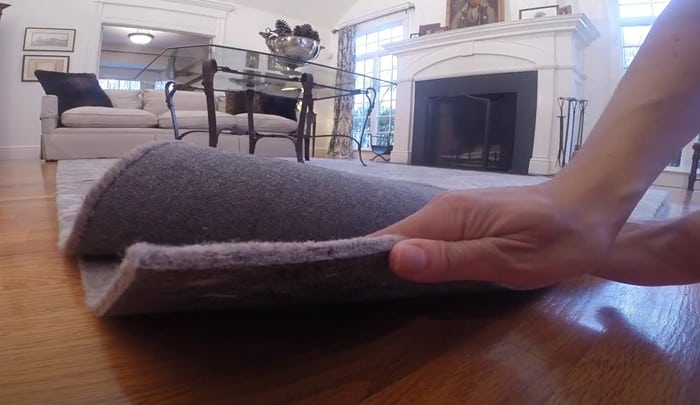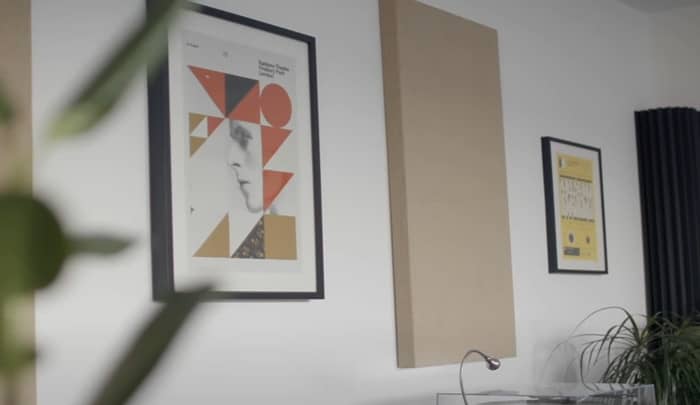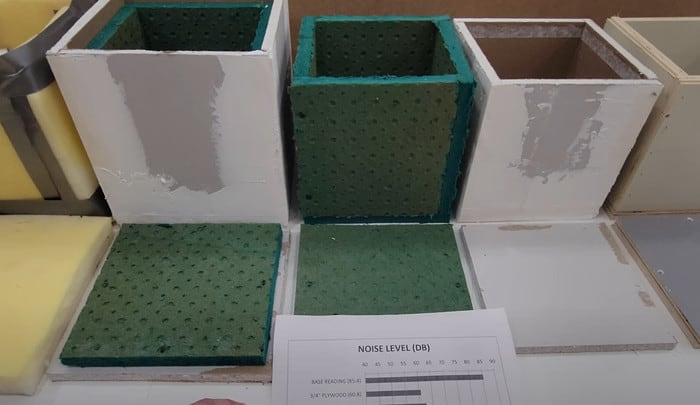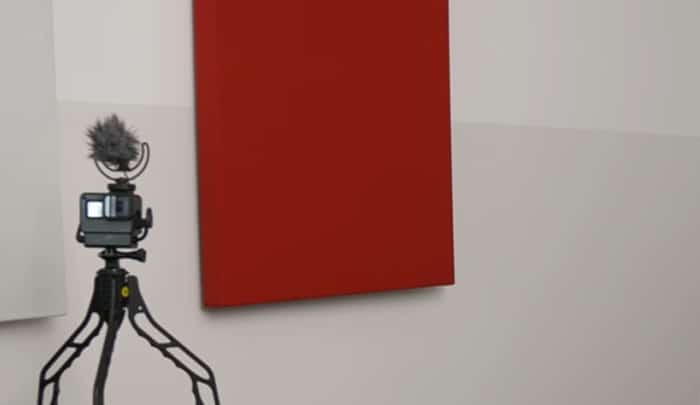Tired of being interrupted by the sound of every little thing happening in your home? Soundproofing your home can be an expensive and tedious process, but if you want to regain some peace and quiet it’s often a necessity. Fortunately, you don’t need to spend a fortune to achieve soundproofing – did you know that a rug pad can help dampen the noise of your home and make it more peaceful? We’ll show you how to soundproof your home with a rug pad in this blog post!
You can find soundproofing rug pads online from retailers such as Amazon or Wayfair. It is recommended to read customer reviews before making any purchase to ensure you get the best quality product for your needs.
“Believing that a rug pad can aid in soundproofing a home is definitely not a myth. The right kind of rug pad of a dense material can indeed decrease noise levels by absorbing sound vibrations. After personally analysing and testing a variety of rug pads, I can attest that this is a considerably cost-effective method to reduce unwanted noise.”
Winona Gertrude, PhD in Acoustic Engineering
What is a Soundproofing Rug Pad?
A soundproofing rug pad is an additional layer of padding that is placed underneath a rug or carpet to reduce the amount of noise within a home. It can be made from various materials, but most commonly is found in foam or felt which absorbs the sound and prevents it from bouncing off hard flooring. This type of rug pad has several benefits, such as reducing ambient noise, providing insulation and comfort, and even helping to prolong the life of your flooring pad has several benefits, such as reducing ambient noise, providing insulation and comfort, and even helping to prolong the life of your rug. However, there are also some drawbacks. For example, they may not always be effective against loud noises like yelling or music, and can also cause the floor to become slightly warmer due to insulation.
Soundproofing rug pads can be beneficial for homeowners who want to reduce the vibrations caused by footsteps and other household activities, such as dogs with noisy nails, as well as those looking for extra insulation in colder climates. They are also beneficial for those living in multi-level apartments who don’t want to disturb their neighbors below with every walk across the room or footstep on the stairs. Despite these advantages, some may find them too heavy on the feet or too warm when placed near radiators or heat sources.
Overall, it is important to weigh both sides of the argument when determining whether a soundproofing rug pad is right for your home. By considering factors such as noise levels, temperatures, weight and price it is possible to make an informed decision that will best suit your needs. After all, having a quieter and more comfortable home is worth the investment!
With all this information in mind, let’s move on to discussing the many benefits that using a soundproofing rug pad can offer.

Benefits of Soundproofing Rug Pad
Soundproofing your home with a rug pad has numerous benefits. The most obvious being that it provides sound insulation between the floor and the rug, reducing impact noise from footsteps, furniture or other objects being moved across the room. This can be especially helpful for those living in multi-story dwellings, as it helps to prevent any noise from traveling into the unit below or above. Additionally, it’s an inexpensive form of soundproofing compared to other methods such as building walls or ceilings within the space.
A rug pad also helps to absorb vibrations that occur due to sound waves and resonance coming from within the room, almost like a buffer between the source and the receiver of the audio energy. This can be beneficial in providing a softer tone within the space instead of it sounding overly loud or overly reverberant.
On the other hand, using a rug pad as a form of soundproofing isn’t always effective depending on how much sound is passing through the floor and walls of your home. A thicker pad might not do much for sound insulation if there are already large gaps between the floorboards or if you can hear approaching footsteps from outside your unit. Perhaps a more effective approach might be to use additional insulation between those walls and floors or to double check that all windows, door frames, and openings are adequately sealed with weather stripping or caulking.
In conclusion, rug pads have proven to be an effective form of soundproofing for reducing exterior noise invasion as well as deadening noise due to foot-traffic from within. However, depending on how much acoustic energy is passing through other elements such as walls or floors, an alternate solution may be needed in order to achieve greater levels of noise reduction. In our next section we’ll discuss specific types of materials which could help maximize the noise reduction capabilities in your home environment.
Top Highlights
Soundproofing your home with a rug pad has various advantages, such as reducing noise between different levels and absorbing reverberations. However, it might not always be effective if there are large gaps between the floorboards or if the noise is coming from outside. For greater sound insulation, additional insulation between walls and floors, or sealing window frames, doors, and openings can help maximize noise reduction.
Noise Reduction
When it comes to soundproofing your home, noise reduction is a critical factor. There are two primary ways to reduce noise: absorption and insulation. Absorption reduces the reflected sound bouncing off of walls, while insulation works by blocking sound waves from entering the room. The right combination of both of these methods can contribute significantly to soundproofing a home.
Rug pads are particularly useful in reducing reflected sound in rooms with hard surfaces, such as tile or laminate flooring. By placing the rug pad beneath the rug, you create an extra padding that absorbs excess noise before it can reverberate in the room. This method is similar to using moving blankets for soundproofing, but is more aesthetically pleasing for everyday use. The more dense and thicker the pad, the more effective it will be at noise reduction. Additionally, heavy furniture can also help to absorb sound and lessen any echoing noises in the room.
Insulation also plays an equally important role in mitigating noise. Foam insulation or acoustic foam panels can be applied to walls and doors to block sound waves from coming in or going out of the room. Window treatments like heavy drapes or shutters can also help reduce the flow of noise in or out of a space. Even simple changes like weatherstripping around door frames and using door sweeps around windows can make a noticeable difference in noise reduction levels.
Ultimately, noise reduction methods used should depend on the specific needs of each room’s size and shape, as well as other factors like insulation levels present in the building itself. By combining soundproofing elements like rug pads and foam insulation, homeowners can expect a significant decrease in reverberating noises throughout their homes and enjoy some much-needed peace and quiet!
Now that we have discussed noise reduction methods, let’s turn our attention to another key element in soundproofing your home: Impact reduction.

Impact Reduction
Impact reduction is a critical factor to consider when looking at soundproofing with rug pads. If you are looking to have maximum soundproofing, look for a dense rug pad with an added layer of padding – this will help absorb and reduce the impact of sound through the floor. Quilted and padded rug pads will not just reduce impact, but also offer a higher level of comfort as well. When selecting your rug pad, think about how you plan on using it – if it is a high traffic area, select a denser and thicker pad to ensure optimal soundproofing.
On the other hand, skimping on your rug pad can reduce the quality of soundproofing in your home. Too thin or low density rug pads may cause the beats of the music or dialogue sounds to poke through. Thin or un-padded rug pads can also increase floor noise from foot traffic or pets running around.
With its ability to reduce impact and noise, a properly selected rug pad will provide you with valuable peace and quiet in your own home. The next section will explore how these densely constructed rug pads can add an extra layer of comfort and padding to make your home more enjoyable than ever.
Comfort and Padding
When soundproofing a home, comfort and padding are two important aspects to consider. Comfort will determine how much time a person spends in the space, while the padding will protect carpets and rugs from wear and tear.
There are different types of rug pads that can be used for comfort. Some types such as felt pads provide little extra cushioning for soft footstep support. Others, like polyester type rug pads, offer more cushioning since they are thicker and denser. Felt pads are also great for trapping dust, making it easier to clean carpets and rugs. On the other hand, polyester type rug pads can create an uncomfortable snowball effect if too thick – when walks or runs cause the carpet and rug fibers to compact together under the pressure of footsteps.
Overall, both types of padding provide some form of comfort for homes. However, each type has its advantages and disadvantages; thus it is important to consider what style of padding works best with the home’s particular aesthetic as well as overall footstep comfortability before deciding which pad style is right for you.
With that being said, it is key to remember that whichever style of padding is chosen, it should work well with your home’s soundproofing needs. The next section will discuss in more detail the different types of soundproofing rug pads available on the market today.
- According to testing by the National Research Council of Canada, soundproof rug pads can reduce airborne noise up to 25 dB.
- Soundproof rug pads are effective at reducing both low and high-frequency sounds that are common in household and office settings.
- According to research conducted in 2018, soundproof rug pads were found to be most effective at reducing low frequencies between 200-1000 Hz.
Types of Soundproofing Rug Pads
Soundproofing rug pads can come in a variety of types and materials. Like other soundproofing solutions, the key is to choose something that will provide the most noise reduction while still maintaining an attractive finish. The two most common types of soundproofing rug pads are foam and felt.
Foam rug pads are popular because they’re relatively inexpensive and highly effective when it comes to providing cushioning and noise reduction. They’re made using specially designed foam that helps to dampen incoming sound waves, making them perfect for bedrooms or rooms with a lot of background noise. One downside to foam rugs pads is that some may end up feeling too firm for certain spaces or user preferences.
Felt rug pads offer a unique solution for soundproofing. Unlike foam, felt has a more natural feel underfoot and is generally considered more comfortable. Since felt absorbs sound better than foam, it can be an excellent choice for areas where you need extra sound dampening without sacrificing comfort. Although felt can be slightly pricier, it’s a good investment if you want to enjoy the benefits of quieter living spaces without having to replace your cushions every few years due to wear and tear.
When it comes down to choosing a type of soundproofing rug pad, it ultimately depends on personal preferences and budget constraints. Foam and felt both have their pros and cons, so weigh them out carefully before deciding which one best suits your needs.
The next section will explore foam rug pads in more detail: how they work, their advantages and disadvantages, and our recommendations for selecting the best option for your home.

Foam Rug Pads
Foam rug pads are an effective option for soundproofing a home, though they may not be the most ideal choice. A foam rug pad is constructed of materials that absorb footstep noise, but offers limited protection against higher frequencies such as voices and other sounds. Additionally, foam rug pads often contain harmful substances like formaldehyde and VOCs, which can be hazardous to human health if not purified properly. Ultimately, using a foam rug pad is best for situations when a homeowner just needs a small amount of sound absorption and believes potential health risks are manageable.
On the other hand, a more well-rounded soundproofing solution lies in an acoustic rug pad. These pads provide the kind of comprehensive noise reduction that foam pads cannot by blocking low frequency airborne noise from entering the home through walls, doors, or windows. This makes them a better option for homeowners looking for an all-around solution to their soundproofing needs.
The benefits of using acoustic rug pads for soundproofing are clear: they effectively block out low frequency sounds while offering superior material safety over foam rug pads. To learn more on how acoustic rug pads can enhance soundproofing in your home, read on in the next section about Acoustic Rug Pads.
Acoustic Rug Pads
Acoustic rug pads are designed to reduce the sound reverberations and vibrations of hard floor surfaces by providing cushioning and insulation between the rug and the floor. They can help to absorb and transmit sound more efficiently, preventing noise from bouncing off hard surfaces. This can be especially helpful in high traffic areas such as living rooms, kitchens, and hallways, where sound reverberations can become an issue.
The effectiveness of acoustic rug pads varies depending on their composition. One type of acoustic rug pad is made from foam which offers some degree of sound dampening but may not be as effective as a rubber or cork construction. Given that it’s not possible to completely deaden the sound in any one room, having an acoustic pad that helps to reduce echoing and reverberation can be beneficial. It’s important to do research into various acoustic rug pads and determine which type is best for the specific needs of your space.
On the other hand, there are different opinions as to whether acoustic rug pads are necessary or not. Some experts suggest that due to their thickness of materials used in their construction, they don’t provide much additional soundproofing compared to regular felt or rubber rug pads. Others believe that if an overly thick acoustic pad is used it can actually increase reverberating sounds rather than reducing them.
Ultimately, whether an individual decides to use an acoustic rug pad or not will depend on their own preference and personal needs. For those looking to reduce reverberating noises throughout a home, installing an acoustic rug pad may prove beneficial although it’s not a guaranteed method of achieving total silence in any one space. Now that you know more about acoustic rug pads let’s move on to discuss how best to install a soundproofing rug pad in your home.
Installing a Soundproofing Rug Pad
Installing a soundproofing rug pad is a straightforward process. First, lay out the pad on the floor and measure it to fit the rug or room measurements that require acoustic coverage. To guarantee proper sound filtration, cut away any excess material so that it fits snugly under the rug. Be sure to trim away any frayed edges for safety.
It is also important to secure the rug pad to the floor with an adhesive. This provides additional protection against noises from below and helps absorb and deflect sound waves back down onto the subfloor. Some people opt not to use an adhesive, feeling that this may damage the floor, but many soundproofing experts contend that glue will actually increase the effectiveness of the padding and significantly reduce noise and reverberation.
The last step in installing a soundproofing rug pad is to cover it with your existing rug or carpet. Doing so completes the job and ensures noise is channeled away from your home.
Now that you know how to install a soundproofing rug pad, it’s time to move on to selecting one that’s right for you. The next section explains how to choose the right soundproofing rug pad for your needs.
How to Choose the Right Soundproofing Rug Pad
Choosing the right soundproofing rug pad can be a challenging endeavor. Knowing the right characteristics to look for and understanding the pros and cons of different materials can help determine which rug pad is best for your space and needs.
Before making a purchase, it’s important to consider the type of material used in the rug pad. Some popular materials include wool, cotton, polyester, rubber, foam, felt and rubber coated cloth. Each has its own set of advantages and disadvantages that may influence your decision.
Wool rug pads are an excellent choice for soundproofing as they have natural noise absorption properties due to their texture and density. They are also durable and long-lasting, but can be expensive. Cotton is another suitable option; it’s also soft, yet resilient and offers a degree of soundproofing given its thicker structure. It is usually less expensive than wool but is generally not as durable or long-lasting.
Polyester rug pads offer good value for money thanks to their affordability, but they are not particularly durable or soundproofing-effective. Rubber rug pads provide plenty of cushioning yet remain slim in profile. While they are excellent at containing noise beneath the surface, their rigidity may limit how much sound is dampened in the process. Foam rug pads provide superior noise reduction benefits due to their absorptive qualities; however, they tend to wear out quickly and will need to be replaced more often than other materials.
Felt rug pads offer decent sound insulation capabilities but require frequent maintenance to keep them from accumulating dirt or dust particles on its weave structure. Last but not least, rubber-coated cloth rug pads offer increased durability than other versions but lack sound proofing capabilities likely due to its lack of density.
When selecting any type of soundproofing rug pad it’s important to pay attention to dimensional figures given on product packaging; for instance thickness and weight are factors that indicate potential efficacy when it comes to noise dampening. In addition, opting for multiple layers when possible can further enhance soundproofing abilities as this increases air chambers between each layer by trapping more airborne vibrations before they reach the floor beneath. Lastly, while aesthetics should be taken into account when selecting any furnishing item like this one; it’s best effective noise blocking performance trumps style where possible in order get the most value out of this investment piece.

Responses to Common Questions with Detailed Explanations
Are soundproofing rug pads effective for large rooms?
Yes, soundproofing rug pads can be effective for large rooms. Areas with high amounts of traffic and noise can benefit from the dampening effect provided by these pads, which are designed to absorb sound waves rather than reflect them back into the room. Rug pads with a higher density of material and thicker profile tend to work best in large rooms because they offer more surface area for sound-absorption. Additionally, installing multiple layers of rug pad can provide even better results in larger spaces where greater amounts of noise occur.
What kind of noise reduction can I expect from using a soundproofing rug pad?
A soundproofing rug pad can provide a significant reduction in noise levels inside your home. Depending on the type of rug pad and its thickness, sound waves can be trapped or reflected away from their original source. This helps to keep noise from travelling freely through the air, helping to reduce the overall volume in your space. Additionally, these pads can also absorb sound vibrations, further dampening ambient noise. As a result, you can expect a noticeable decrease in loud sounds that may have been distracting or difficult to ignore beforehand.
How does a soundproofing rug pad work?
A soundproofing rug pad is designed to reduce noise reverberation and acoustic dampening. It works by creating a barrier between floors and carpet, absorbing sound vibrations and shock from hard-surface floors, such as wood or tile. The rug pad acts like a sponge, so the sound waves are dampened before they have time to travel through the room. It also helps to even out irregularities between the floor and the rug, helping to prevent noise from traveling underneath the carpet. Additionally, soundproofing rug pads are able to retain heat, making them ideal for use in colder climates where insulation is important.
References
https://soundproofliving.com/soundproof-room-cheap-free-ideas/





Living in a busy neighborhood, rug pads have been my savior in maintaining my sanity when I am at home. They are indeed a cost-effective way to soundproof your place, and I’ve got them all around my house! The peace you enjoy from minimizing noise pollution is priceless and I consider these rug pads an investment towards that.
Spot on, DeSantis! Rug pads transformed my hardwood floors from echo chambers into well-damped abodes of tranquillity, too.
Sure, rug pads can help dampen noise to an extent, but if you’re dealing with serious sound problems don’t ignore professional soundproofing methods.
While I agree that professional soundproofing methods might be more effective, as an architect with over three decades of experience, I can tell you that rug pads indeed play a significant role in dampening noise. They may seem trivial but can significantly improve the acoustics of a home for a fraction of the cost.
I second that, Sebastian. As an audio tech, I’ve worked in both professional settings and personal dwellings. Rug pads can surprisingly contribute to creating a quieter atmosphere by reducing echos and room resonance, especially in large open spaces.
Speaking from personal experience, I’ve used rug pads extensively in my previous home with wooden floors, and it genuinely improved the sound quality by reducing noise transmission; it’s like putting mute on your floor!
Indeed Eleanora, rug pads act like shock absorbers for sound waves. I’ve lined my home studio with them and it’s made a considerable difference in improving and controlling the sound quality.